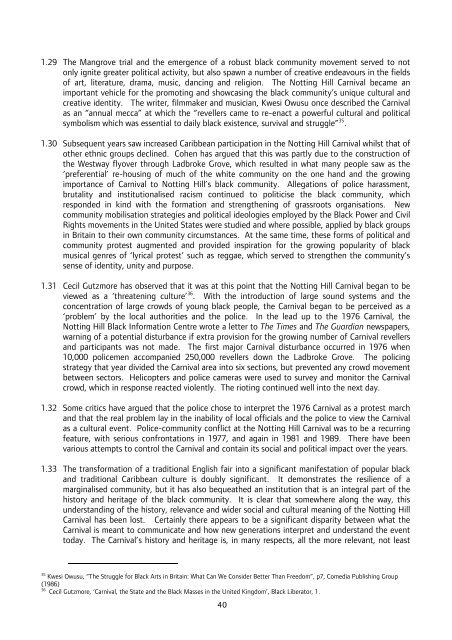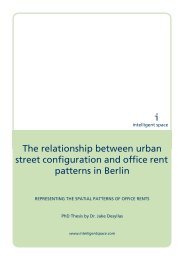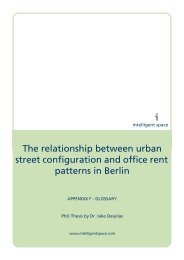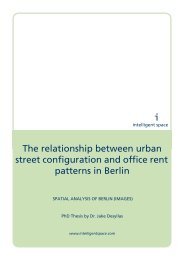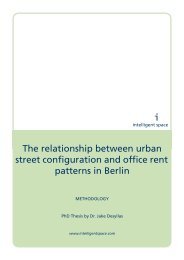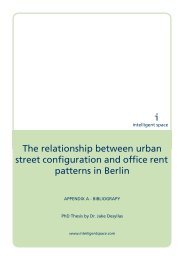Notting Hill Carnival Strategic Review - Intelligent Space
Notting Hill Carnival Strategic Review - Intelligent Space
Notting Hill Carnival Strategic Review - Intelligent Space
You also want an ePaper? Increase the reach of your titles
YUMPU automatically turns print PDFs into web optimized ePapers that Google loves.
1.29 The Mangrove trial and the emergence of a robust black community movement served to not<br />
only ignite greater political activity, but also spawn a number of creative endeavours in the fields<br />
of art, literature, drama, music, dancing and religion. The <strong>Notting</strong> <strong>Hill</strong> <strong>Carnival</strong> became an<br />
important vehicle for the promoting and showcasing the black community’s unique cultural and<br />
creative identity. The writer, filmmaker and musician, Kwesi Owusu once described the <strong>Carnival</strong><br />
as an “annual mecca” at which the “revellers came to re-enact a powerful cultural and political<br />
symbolism which was essential to daily black existence, survival and struggle” 35 .<br />
1.30 Subsequent years saw increased Caribbean participation in the <strong>Notting</strong> <strong>Hill</strong> <strong>Carnival</strong> whilst that of<br />
other ethnic groups declined. Cohen has argued that this was partly due to the construction of<br />
the Westway flyover through Ladbroke Grove, which resulted in what many people saw as the<br />
‘preferential’ re-housing of much of the white community on the one hand and the growing<br />
importance of <strong>Carnival</strong> to <strong>Notting</strong> <strong>Hill</strong>’s black community. Allegations of police harassment,<br />
brutality and institutionalised racism continued to politicise the black community, which<br />
responded in kind with the formation and strengthening of grassroots organisations. New<br />
community mobilisation strategies and political ideologies employed by the Black Power and Civil<br />
Rights movements in the United States were studied and where possible, applied by black groups<br />
in Britain to their own community circumstances. At the same time, these forms of political and<br />
community protest augmented and provided inspiration for the growing popularity of black<br />
musical genres of ‘lyrical protest’ such as reggae, which served to strengthen the community’s<br />
sense of identity, unity and purpose.<br />
1.31 Cecil Gutzmore has observed that it was at this point that the <strong>Notting</strong> <strong>Hill</strong> <strong>Carnival</strong> began to be<br />
viewed as a ‘threatening culture’ 36 . With the introduction of large sound systems and the<br />
concentration of large crowds of young black people, the <strong>Carnival</strong> began to be perceived as a<br />
‘problem’ by the local authorities and the police. In the lead up to the 1976 <strong>Carnival</strong>, the<br />
<strong>Notting</strong> <strong>Hill</strong> Black Information Centre wrote a letter to The Times and The Guardian newspapers,<br />
warning of a potential disturbance if extra provision for the growing number of <strong>Carnival</strong> revellers<br />
and participants was not made. The first major <strong>Carnival</strong> disturbance occurred in 1976 when<br />
10,000 policemen accompanied 250,000 revellers down the Ladbroke Grove. The policing<br />
strategy that year divided the <strong>Carnival</strong> area into six sections, but prevented any crowd movement<br />
between sectors. Helicopters and police cameras were used to survey and monitor the <strong>Carnival</strong><br />
crowd, which in response reacted violently. The rioting continued well into the next day.<br />
1.32 Some critics have argued that the police chose to interpret the 1976 <strong>Carnival</strong> as a protest march<br />
and that the real problem lay in the inability of local officials and the police to view the <strong>Carnival</strong><br />
as a cultural event. Police-community conflict at the <strong>Notting</strong> <strong>Hill</strong> <strong>Carnival</strong> was to be a recurring<br />
feature, with serious confrontations in 1977, and again in 1981 and 1989. There have been<br />
various attempts to control the <strong>Carnival</strong> and contain its social and political impact over the years.<br />
1.33 The transformation of a traditional English fair into a significant manifestation of popular black<br />
and traditional Caribbean culture is doubly significant. It demonstrates the resilience of a<br />
marginalised community, but it has also bequeathed an institution that is an integral part of the<br />
history and heritage of the black community. It is clear that somewhere along the way, this<br />
understanding of the history, relevance and wider social and cultural meaning of the <strong>Notting</strong> <strong>Hill</strong><br />
<strong>Carnival</strong> has been lost. Certainly there appears to be a significant disparity between what the<br />
<strong>Carnival</strong> is meant to communicate and how new generations interpret and understand the event<br />
today. The <strong>Carnival</strong>’s history and heritage is, in many respects, all the more relevant, not least<br />
35<br />
Kwesi Owusu, “The Struggle for Black Arts in Britain: What Can We Consider Better Than Freedom”, p7, Comedia Publishing Group<br />
(1986)<br />
36<br />
Cecil Gutzmore, ‘<strong>Carnival</strong>, the State and the Black Masses in the United Kingdom’, Black Liberator, 1.<br />
40


